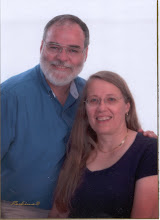A member of my ladies' Bibly study group was recently diagnosed with a severe egg allergy, and she has been avoiding bread, since apparently some of the commercial loaves have egg-derived ingredients. I'm going to give her a loaf of this and the recipe.
Basic White Bread (adapted from James Beard)
Sprinkle 1T active dry yeast over 1/2 cup warm water (110 to 115 degrees F.) Stir in 2t. sugar or honey.
In a larger bowl, combine 1 1/2 cups warm water and 1 T salt. Slowly stir in 1 cup all-purpose flour. Once the yeast has bubbled and foamed, add the yeast mixture. Stir in an additional 2 cups flour.
Sprinkle about 1/2 cup flour on the counter top, and turn the dough out onto the floured surface. With floured hands, knead the dough by pushing down and away with the heels of your hands. Fold the back of the dough over the front, turn the whole thing 1//4 turn (90 degrees) and repeat. Knead until the dough no longer feels sticky, adding more flour if needed, up to 1/2 cup additional. (This will take about 5 minutes.)
Pour a little oil (1 to 2 T.) into the mixing bowl, form the dough into a ball, and place it in the bowl, turning it over so that all sides are coated with oil. Set in a warm place to rise. (Our oven can be set to 100 degrees F., so we usually preheat it and turn it off. The only reason to cover a bowl of rising dough is to protect it from critters or drafts, which are not an issue in the oven.)
In 1 1/2 hours or so, check if the dough is risen by poking it with two fingers. If the dents stay, it's ready! Turn the dough out onto the counter (we don't wash it in between; add a tiny bit of flour if you need it for other things in the meantime) and knead again for a few minutes.
Allow the dough to rest on the counter while you grease the pan(s). This will make one large loaf in a 9 x 5 inch pan, or two smaller loaves in 8 x 4 pans. And if you have no bread pans, it will make a nice free-form loaf baked on a cookie sheet.. Next, form the dough into (a) smooth round or oval shape(s) and place in the pan(s). Allow to rise for about 45 minutes. Don't poke the dough this time; if it's obviously risen above the edge of the pans (or spread some on the cookie sheet) it's ready.
Preheat the oven to 350 degrees. (If your oven tends to be slow or fast, adjust the temperature accordingly.) Bake the bread in the lower third of the oven for 35 to 50 minutes, checking after 35. It's done when it sounds hollow when you knock on the top. If the bottom is not yet golden but the loaf sounds hollow, place the bread directly on the oven rack (no pan) for about 5 minutes, but watch it carefully!
Cool the finished bread on a rack until you can't wait any longer. We like to brush ours with melted butter, which gives a slightly more tender crust. If you do cut into a hot loaf, cool the uneaten part cut-side down so that the rest of the loaf doesn't dry out.
This bread freezes well. We (actually Roger, who taught me to make bread) often make 18 loaves -- 3 triple batches -- in one day. We freeze it in half loaves, and often give it away, since "Dad's bread" toast is one of the things both Arwen and Branwen can eat in early pregnancy. We also cut a slice or two on the end of each half loaf before freezing, so that it can be popped into the toaster straight from the freezer if "thaw bread" doesn't make it to the top of the priority list!
Subscribe to:
Post Comments (Atom)

1 comment:
What a thoughtful gesture! While your friend may be different, my sister also has a severe egg allergy (she carries an Epipen for it) and for what it's worth, in her case, she does all right with store-bought bread, except for Italiano brand buns (I think that's the name), for which "may contain traces of egg" actually means "does contain traces of egg". My sister can tell if something contains egg the moment she puts it in her mouth - it's her own allergy superpower.
Of course, it goes without saying, now that your friend has sampled the real stuff, the commercial stuff will pale in comparison.
Post a Comment